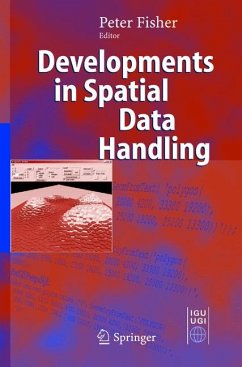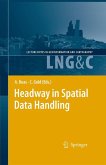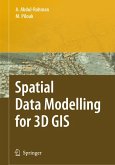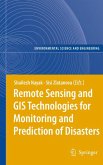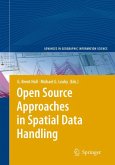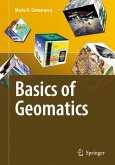Developments in Spatial Data Handling (eBook, PDF)
11th International Symposium on Spatial Data Handling
Redaktion: Fisher, Peter F.
161,95 €
161,95 €
inkl. MwSt.
Sofort per Download lieferbar

81 °P sammeln
161,95 €
Als Download kaufen

161,95 €
inkl. MwSt.
Sofort per Download lieferbar

81 °P sammeln
Jetzt verschenken
Alle Infos zum eBook verschenken
161,95 €
inkl. MwSt.
Sofort per Download lieferbar
Alle Infos zum eBook verschenken

81 °P sammeln
Developments in Spatial Data Handling (eBook, PDF)
11th International Symposium on Spatial Data Handling
Redaktion: Fisher, Peter F.
- Format: PDF
- Merkliste
- Auf die Merkliste
- Bewerten Bewerten
- Teilen
- Produkt teilen
- Produkterinnerung
- Produkterinnerung

Bitte loggen Sie sich zunächst in Ihr Kundenkonto ein oder registrieren Sie sich bei
bücher.de, um das eBook-Abo tolino select nutzen zu können.
Hier können Sie sich einloggen
Hier können Sie sich einloggen
Sie sind bereits eingeloggt. Klicken Sie auf 2. tolino select Abo, um fortzufahren.

Bitte loggen Sie sich zunächst in Ihr Kundenkonto ein oder registrieren Sie sich bei bücher.de, um das eBook-Abo tolino select nutzen zu können.
The International Symposium on Spatial Data Handling is the premier research forum for Geographic Information Science. The Symposium is particularly strong in respect to identifying significant new developments in this field. The papers published in this volume are carefully refereed by an international programme committee composed of experts in various areas of GIS who are especially renowned for their scientific innovation.
- Geräte: PC
- ohne Kopierschutz
- eBook Hilfe
- Größe: 13.37MB
Andere Kunden interessierten sich auch für
![Headway in Spatial Data Handling (eBook, PDF) Headway in Spatial Data Handling (eBook, PDF)]() Headway in Spatial Data Handling (eBook, PDF)233,95 €
Headway in Spatial Data Handling (eBook, PDF)233,95 €![Geographic Information and Cartography for Risk and Crisis Management (eBook, PDF) Geographic Information and Cartography for Risk and Crisis Management (eBook, PDF)]() Geographic Information and Cartography for Risk and Crisis Management (eBook, PDF)113,95 €
Geographic Information and Cartography for Risk and Crisis Management (eBook, PDF)113,95 €![The European Information Society (eBook, PDF) The European Information Society (eBook, PDF)]() The European Information Society (eBook, PDF)113,95 €
The European Information Society (eBook, PDF)113,95 €![Spatial Data Modelling for 3D GIS (eBook, PDF) Spatial Data Modelling for 3D GIS (eBook, PDF)]() Alias Abdul-RahmanSpatial Data Modelling for 3D GIS (eBook, PDF)113,95 €
Alias Abdul-RahmanSpatial Data Modelling for 3D GIS (eBook, PDF)113,95 €![Remote Sensing and GIS Technologies for Monitoring and Prediction of Disasters (eBook, PDF) Remote Sensing and GIS Technologies for Monitoring and Prediction of Disasters (eBook, PDF)]() Remote Sensing and GIS Technologies for Monitoring and Prediction of Disasters (eBook, PDF)113,95 €
Remote Sensing and GIS Technologies for Monitoring and Prediction of Disasters (eBook, PDF)113,95 €![Open Source Approaches in Spatial Data Handling (eBook, PDF) Open Source Approaches in Spatial Data Handling (eBook, PDF)]() Open Source Approaches in Spatial Data Handling (eBook, PDF)113,95 €
Open Source Approaches in Spatial Data Handling (eBook, PDF)113,95 €![Basics of Geomatics (eBook, PDF) Basics of Geomatics (eBook, PDF)]() Mario A. GomarascaBasics of Geomatics (eBook, PDF)177,95 €
Mario A. GomarascaBasics of Geomatics (eBook, PDF)177,95 €-
-
-
The International Symposium on Spatial Data Handling is the premier research forum for Geographic Information Science. The Symposium is particularly strong in respect to identifying significant new developments in this field. The papers published in this volume are carefully refereed by an international programme committee composed of experts in various areas of GIS who are especially renowned for their scientific innovation.
Dieser Download kann aus rechtlichen Gründen nur mit Rechnungsadresse in A, B, BG, CY, CZ, D, DK, EW, E, FIN, F, GR, HR, H, IRL, I, LT, L, LR, M, NL, PL, P, R, S, SLO, SK ausgeliefert werden.
Produktdetails
- Produktdetails
- Verlag: Springer Berlin Heidelberg
- Seitenzahl: 676
- Erscheinungstermin: 28. Februar 2006
- Englisch
- ISBN-13: 9783540267720
- Artikelnr.: 37370068
- Verlag: Springer Berlin Heidelberg
- Seitenzahl: 676
- Erscheinungstermin: 28. Februar 2006
- Englisch
- ISBN-13: 9783540267720
- Artikelnr.: 37370068
- Herstellerkennzeichnung Die Herstellerinformationen sind derzeit nicht verfügbar.
Plenary of Submitted Papers.- About Invalid, Valid and Clean Polygons.- 3D Geographic Visualization: The Marine GIS.- Local Knowledge Doesn't Grow on Trees: Community-Integrated Geographic Information Systems and Rural Community Self-Definition.- Web GIS.- A Flexible Competitive Neural Network for Eliciting User's Preferences in Web Urban Spaces.- Combining Heterogeneous Spatial Data From Distributed Sources.- Security for GIS N-tier Architecture.- Progressive Transmission of Vector Data Based on Changes Accumulation Model.- Elevation modelling.- An Efficient Natural Neighbour Interpolation Algorithm for Geoscientific Modelling.- Evaluating Methods for Interpolating Continuous Surfaces from Irregular Data: a Case Study.- Contour Smoothing Based on Weighted Smoothing Splines.- Flooding Triangulated Terrain.- Vagueness and Interpolation.- Vague Topological Predicates for Crisp Regions through Metric Refinements.- Fuzzy Modeling of Sparse Data.- Handling Spatial Data Uncertainty Using a Fuzzy Geostatistical Approach for Modelling Methane Emissions at the Island of Java.- Temporal.- A Visualization Environment for the Space-Time-Cube.- Finding REMO - Detecting Relative Motion Patterns in Geospatial Lifelines.- Indexing.- Spatial Hoarding: A Hoarding Strategy for Location-Dependent Systems.- Distributed Ranking Methods for Geographic Information Retrieval.- Representing Topological Relationships between Complex Regions by F-Histograms.- The Po-tree: a Real-time Spatiotemporal Data Indexing Structure.- Uncertainty.- Empirical Study on Location Indeterminacy of Localities.- Registration of Remote Sensing Image with Measurement Errors and Error Propagation.- Double Vagueness: Effect of Scale on the Modelling of Fuzzy Spatial Objects.- Area, Perimeter and Shape of FuzzyGeographical Entities.- Generalisation.- Why and How Evaluating Generalised Data ?.- Road Network Generalization Based on Connection Analysis.- Continuous Generalization for Visualization on Small Mobile Devices.- Shape-Aware Line Generalisation With Weighted Effective Area.- Spatial Relationships.- Introducing a Reasoning System Based on Ternary Projective Relations.- A Discrete Model for Topological Relationships between Uncertain Spatial Objects.- Modeling Topological Properties of a Raster Region for Spatial Optimization.- Sandbox Geography - To learn from children the form of spatial concepts.- Urban Infrastructure.- Street Centreline Generation with an Approximated Area Voronoi Diagram.- Determining Optimal Critical Junctions for Real- time Traffic Monitoring for Transport GIS.- Collaborative Decision Support for Spatial Planning and Asset Management: IIUM Total Spatial Information System.- Navigation.- Automatic Generation and Application of Landmarks in Navigation Data Sets.- Towards a Classification of Route Selection Criteria for Route Planning Tools.- An Algorithm for Icon Labelling on a Real-Time Map.- Working with Elevation.- Semantically Correct 2.5D GIS Data - the Integration of a DTM and Topographic Vector Data.- Generalization of integrated terrain elevation and 2D object models.- An Image Analysis and Photogrammetric Engineering Integrated Shadow Detection Model.- Semantics and Ontologies.- Understanding Taxonomies of Ecosystems: a Case Study.- Comparing and Combining Different Expert Relations of How Land Cover Ontologies Relate.- Representing, Manipulating and Reasoning with Geographic Semantics within a Knowledge Framework.- Data Quality and Metadata.- A Framework for Conceptual Modeling of Geographic Data Quality.- Consistency AssessmentBetween Multiple Representations of Geographical Databases: a Specification-Based Approach.- Integrating structured descriptions of processes in geographical metadata.- Spatial Statistics.- Toward Comparing Maps as Spatial Processes.- Integrating computational and visual analysis for the exploration of health statistics.- Using Spatially Adaptive Filters to Map Late Stage Colorectal Cancer Incidence in Iowa.
Plenary of Submitted Papers.- About Invalid, Valid and Clean Polygons.- 3D Geographic Visualization: The Marine GIS.- Local Knowledge Doesn't Grow on Trees: Community-Integrated Geographic Information Systems and Rural Community Self-Definition.- Web GIS.- A Flexible Competitive Neural Network for Eliciting User's Preferences in Web Urban Spaces.- Combining Heterogeneous Spatial Data From Distributed Sources.- Security for GIS N-tier Architecture.- Progressive Transmission of Vector Data Based on Changes Accumulation Model.- Elevation modelling.- An Efficient Natural Neighbour Interpolation Algorithm for Geoscientific Modelling.- Evaluating Methods for Interpolating Continuous Surfaces from Irregular Data: a Case Study.- Contour Smoothing Based on Weighted Smoothing Splines.- Flooding Triangulated Terrain.- Vagueness and Interpolation.- Vague Topological Predicates for Crisp Regions through Metric Refinements.- Fuzzy Modeling of Sparse Data.- Handling Spatial Data Uncertainty Using a Fuzzy Geostatistical Approach for Modelling Methane Emissions at the Island of Java.- Temporal.- A Visualization Environment for the Space-Time-Cube.- Finding REMO - Detecting Relative Motion Patterns in Geospatial Lifelines.- Indexing.- Spatial Hoarding: A Hoarding Strategy for Location-Dependent Systems.- Distributed Ranking Methods for Geographic Information Retrieval.- Representing Topological Relationships between Complex Regions by F-Histograms.- The Po-tree: a Real-time Spatiotemporal Data Indexing Structure.- Uncertainty.- Empirical Study on Location Indeterminacy of Localities.- Registration of Remote Sensing Image with Measurement Errors and Error Propagation.- Double Vagueness: Effect of Scale on the Modelling of Fuzzy Spatial Objects.- Area, Perimeter and Shape of FuzzyGeographical Entities.- Generalisation.- Why and How Evaluating Generalised Data ?.- Road Network Generalization Based on Connection Analysis.- Continuous Generalization for Visualization on Small Mobile Devices.- Shape-Aware Line Generalisation With Weighted Effective Area.- Spatial Relationships.- Introducing a Reasoning System Based on Ternary Projective Relations.- A Discrete Model for Topological Relationships between Uncertain Spatial Objects.- Modeling Topological Properties of a Raster Region for Spatial Optimization.- Sandbox Geography - To learn from children the form of spatial concepts.- Urban Infrastructure.- Street Centreline Generation with an Approximated Area Voronoi Diagram.- Determining Optimal Critical Junctions for Real- time Traffic Monitoring for Transport GIS.- Collaborative Decision Support for Spatial Planning and Asset Management: IIUM Total Spatial Information System.- Navigation.- Automatic Generation and Application of Landmarks in Navigation Data Sets.- Towards a Classification of Route Selection Criteria for Route Planning Tools.- An Algorithm for Icon Labelling on a Real-Time Map.- Working with Elevation.- Semantically Correct 2.5D GIS Data - the Integration of a DTM and Topographic Vector Data.- Generalization of integrated terrain elevation and 2D object models.- An Image Analysis and Photogrammetric Engineering Integrated Shadow Detection Model.- Semantics and Ontologies.- Understanding Taxonomies of Ecosystems: a Case Study.- Comparing and Combining Different Expert Relations of How Land Cover Ontologies Relate.- Representing, Manipulating and Reasoning with Geographic Semantics within a Knowledge Framework.- Data Quality and Metadata.- A Framework for Conceptual Modeling of Geographic Data Quality.- Consistency AssessmentBetween Multiple Representations of Geographical Databases: a Specification-Based Approach.- Integrating structured descriptions of processes in geographical metadata.- Spatial Statistics.- Toward Comparing Maps as Spatial Processes.- Integrating computational and visual analysis for the exploration of health statistics.- Using Spatially Adaptive Filters to Map Late Stage Colorectal Cancer Incidence in Iowa.
